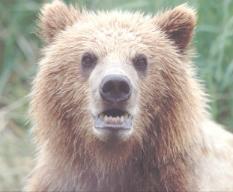
“Alive, the grizzly is a symbol of freedom
and understanding – a sign that man can
learn to conserve what is left of the earth.
Extinct, it will be another fading testimony
to things man should have learned more
about but was too preoccupied with himself
to notice.
In its beleaguered condition,
it is above all a symbol of what man is
doing to the entire planet.
If we can learn from these experiences,
and learn rationally, both the grizzly
and man may have a chance.”
Frank C. Craighead Jr.
Frank Craighead, Jr., one of the fathers of grizzly bear research in the US, was honored this last summer by the Interagency Grizzly Bear Committee for excellence in research and leadership in advancing grizzly bear recovery. He is noted for being one of the first to employ radio collar technology and for his publications, among them "Track of the Grizzly" and Petersons Field guides and numerours documentary films. Frank passed away in 2001, at the age of 85.
Julie L. Hopkins
photo: grizzly on katmai shore




